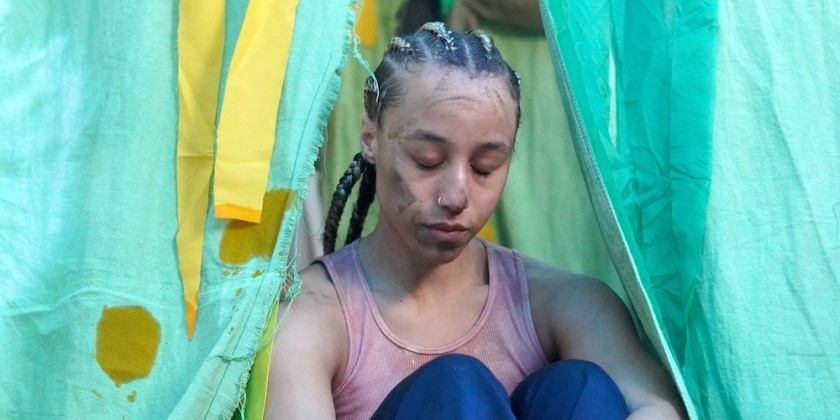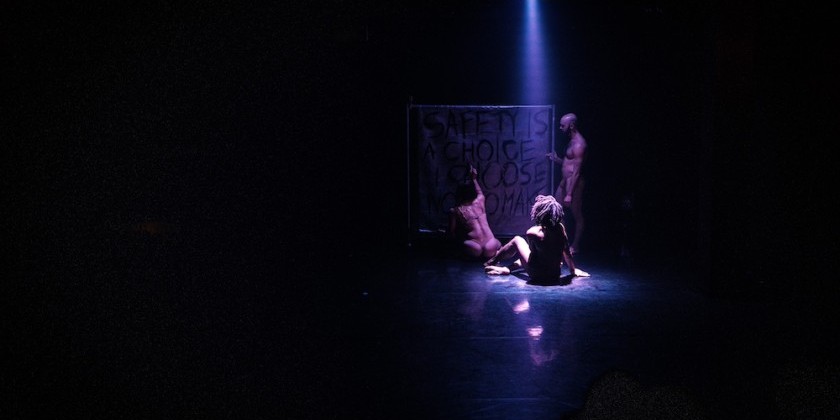IMPRESSIONS: Dominica Greene in "ENUF" at Triskelion Arts

Concept and Performance: Dominica Greene, Resident Research Artist at Triskelion
Dramaturgy: Tushrik Fredericks
Courtyard Designer / Creative Archivist: Myssi Robinson
Costume Design: Malcolm X Betts
Costume Design: Kate Williams
Lighting Design: Connor Sale
Music: Hiroshi Yoshimura, Deadbeat & Om Unit, Dravier
What are the ingredients in the making of self? What is the composition of the soil that gives nourishment to its roots? What are the elements of care and cultivation that make possible its blossoming? Every self finds their own answers to these questions through a lifelong journey of growth and discovery. In ENUF, artist Dominica Greene unfolds an expressive ecosystem of movement, image, sound, text, and installation to mine the complexities of her multidimensional self. In the process she honors ancestry, land, and queer womanhood through an intimate and loving portrait of family, nature, and self.

Greene’s multidisciplinary performance opens through material and sensory experience: an installation in Triskelion Arts’ small courtyard, designed by Myssi Robinson. Diaphanous fabrics in greens and blues billow in the light breeze; walls and corners adorned with mirrors, plants, and pots of rich brown soil speak of the exchanges between origins, growth, and reflections. The sound of waves conjures a distant shore, transporting the slowly-processing audience into her world.

The interior performance space is stark: a white square on black floor lit by fluorescent bar lights. As the audience settles, Greene — strong in presence with eyes downcast and hair braided down her back — walks the perimeter in slow motion. She accelerates imperceptibly at first, pace quickening as fists gently unfurl into the swing of a natural gait. Her footfalls grow heavier, arms pumping and stride widening as she leans into momentum; the sound of her breath audible through the silence, a hum rumbling underneath. Her breath assumes the rhythm of her feet, arms flying out behind her as if casting off a weight; lights flicker and flash, coalescing along the narrow corridors of her square perimeter. Feet slap floor, hands slap face and body as she breaks into a run, eyes aimed forward through a full-bodied ambulatory shake. Bursting — it must be 15 minutes — she slows to crouch at center, hand hovering over the hard edge where black floor meets white, she caresses the air at the boundary and steps inside.

Sound slowly fills the space as she shifts through waves of sculptured forms encased in womb-like softness. She enfolds and unfolds with every sensitive turn of limb and joint, hands spreading gently across her body, arms spreading wide as wings. The arc of effort and ease, of strength and resilience, is a prelude for what’s to come.
Three large burlap sacks of soil serve as interlocutors for a movement monologue sequence inspired by the feminist prose of Ntozake Shange and Alice Walker. Greene threads herself through Walker’s “womanist” manifesto to connect and reconcile girl-self and grown-self, woman-self and queer-self, a mixed and blended self shaped by heritage and memory. As she speaks she drags the heavy bags around her white square, feeling their weight in effort and ease as she rests her body on them or rests them on her body, sensing with small sighs of fatigue the ever-presence of weight in shifting relationships. Soft street sounds fill the space, entering into an exchange of voices and memories, small anecdotes around instinct, learning, and growth — again, a prelude.

Flashing lights and booming bass swallow the voices as color and sound suffuse the space, rhythmically pulsating in electric blue and magenta. Greene’s body ripples, drops, and trembles through shattered symmetries and repetitions as she unfurls wide cloths from the grid above to create a white enclosure. Energized yet unfrenzied, she spills and spreads the dark soil, crawling and rolling and coming to rest as video projections of green trees and blue skies fill the walls of her dream cave.

Greene lingers in this place — her grandparents’ home and garden in Guyana — in a loving meditation. Her grandmother’s cheeky, melodious voice meanders through memories as photos and videos conjure the place: the green and bright and wet of life, the wild and cultivated, exotic bird calls and quotidian caretaking. All the while Greene is a bulb in her soil, morphing and rising slowly to blossom, place and voice written on her soil-smudged body. She rests to watch her home video collage: the small nothings and everythings of ancestral wealth in daily life, her eyes, hands, and camera witness to her grandmother’s small songs and gestures, jokes and dances and fierce tenderness. She reads bits of the same text Greene danced — “womanist is to feminist as purple is to lavender” — and slowly, through gentle repetition, comes to understand. A spreading mango tree fills the sky, nourished by the land from hidden roots to branching leaves.

Greene’s ancestors smile as she smiles, laugh as she laughs, and the presence of her family in the audience fills the space with warmth and recognition. Her offering is for them as much as it is for herself; for someone like me, it feels almost undeserved: an intimate gift of self-revelation and self-discovery through love.




![IMPRESSIONS: [RE]DEFINING [SPACE] at Triskelion Arts](/images/features_small/3_Trisk_day_3_selects_by_caroline_alarcon_loor_064.png)






